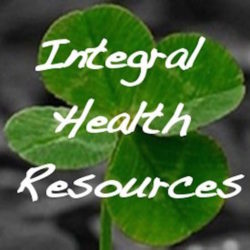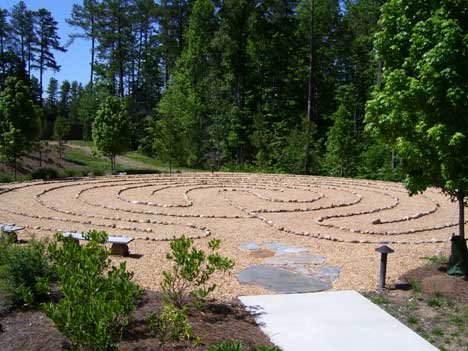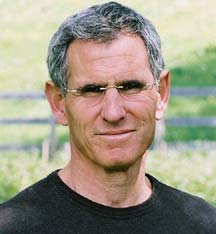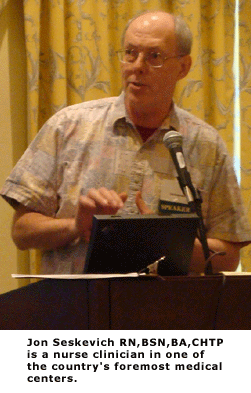From the March 2010 issue of the Shambhala Sun:
MINDFUL LIVING: THE PIONEER
 As creator of Mindfulness-Based Stress Reduction, Jon Kabat-Zinn has brought the benefits of meditation practice to hundreds of thousands of people and inspired a movement that is changing our society in many ways. In this exclusive interview with the Sun’s Barry Boyce, he discusses the philosophy, goals, and promise of the mindfulness movement.
As creator of Mindfulness-Based Stress Reduction, Jon Kabat-Zinn has brought the benefits of meditation practice to hundreds of thousands of people and inspired a movement that is changing our society in many ways. In this exclusive interview with the Sun’s Barry Boyce, he discusses the philosophy, goals, and promise of the mindfulness movement.
Barry Boyce: Does mindfulness go beyond simply cultivating our attentiveness?
Jon Kabat-Zinn: The ultimate promise of mindfulness is much larger than that, more profound. It helps us understand that our conventional view of ourselves and even what we mean by “self” is incomplete in some very important ways. Mindfulness helps us recognize how and why we mistake the actuality of things for some story we create, and then makes it possible to chart a path toward greater sanity, well-being, and purpose.
Based on that understanding, how would you describe the central mission of your work?
In part 2 of Coming to Our Senses, I talked explicitly about the word dharma—describing it both in terms of the teachings of the Buddha (with a capital D, often spoken of as Buddhadharma) and also as the way things are, the fundamental lawfulness of the universe. So although the Buddha articulated the Dharma, the Dharma itself can’t be Buddhist any more than the law of gravity is English because of Newton, or Italian because of Galileo. It is a universal lawfulness. I specifically asked His Holiness the Dalai Lama at the Mind and Life XIII conference in Washington, D.C., in 2005 whether there was any fundamental difference between Buddhadharma and universal dharma and he said “no.”
The central mission of my work and that of my colleagues at the Center for Mindfulness has been to bring universal dharma into the mainstream of human activity for the benefit of as many people as possible. That’s a very broad calling, so as a skillful means I chose very consciously from the beginning to anchor it in medicine and healthcare. I thought that would be the most fertile ground for introducing meditation and the wisdom and compassion of the dharma in its universal aspect to a wider world, hopefully in an authentic and meaningful way. After all, hospitals function as dukkha magnets in our society, so what better place for the teachings of suffering and the end of suffering to be made available in ways that people might be able to resonate with and adopt as their own?
This year, we’ve been celebrating the thirtieth anniversary of the founding of the Stress Reduction Clinic at the UMass Medical Center. The original vision has in some sense come to fruition, because Mindfulness-Based Stress Reduction has indeed spread to hospitals, clinics, and laboratories around the world. It’s being researched, offered clinically, and experimented with in ways that were virtually inconceivable thirty years ago. I think that has come about because the world is longing for authentic experience that transcends the usual limitations we impose on ourselves—through cultural traditions, ideologies, belief systems, and so forth. People are searching for ways to realize the full spectrum of their humanity.
Why do you think a scientific approach is important in spreading the practice of mindfulness?
I am not really interested in “spreading” mindfulness, so much as I am interested in igniting passion in people for what is deepest and best within all of us, but which is usually hidden and rarely accessible. Science is a particular way of understanding the world that allows some people to approach what they would otherwise shun, and so can be used as a skillful means for opening people’s minds. By bringing science together with meditation, we’re beginning to find new ways, in language people can understand, to show the benefits of training oneself to become intimate with the workings of one’s own mind in a way that generates greater insight and clarity.
The science is also showing interesting and important health benefits of such mind–body training and practices, and is now beginning to elucidate the various pathways though which mindfulness may be exerting its effects on the brain (emotion regulation, working memory, cognitive control, attention, activation in specific somatic maps of the body, cortical thickening in specific regions) and the body (symptom reduction, greater physical well-being, immune function enhancement, epigenetic up and down regulation of activity in large numbers and classes of genes). It is also showing that meditation can bring a sense of meaning and purpose to life, based on understanding the nonseparation of self and other. Given the condition we find ourselves in these days on this planet, understanding our interconnectedness is not a spiritual luxury; it’s a societal imperative.
Three or four hundred years ago, not so long in the scheme of things, people practicing meditation did so under fairly isolated conditions, mostly in monasteries. Now meditation is being practiced and studied in laboratories, hospitals, and clinics, and is even finding its way into primary and secondary schools. The people teaching and researching it have in many cases been involved with mindfulness for ten, twenty, thirty, or more years by now. They are not just jumping on some new mindfulness bandwagon. And their work has resulted in many professionals being drawn to mindfulness for the first time. That in itself is a wonderful phenomenon, as long as it is understood that mindfulness is not merely a nice “concept” but an orthogonal way of being that requires ongoing practice and cultivation.
What are some of the new frontiers that mindfulness has entered in recent years?
The mindfulness work is spilling into areas way beyond medicine and healthcare and also beyond psychology and neuroscience. It’s moving into programs on childbirth and parenting, education, business, athletics and professional sports, the legal profession, criminal justice, even politics. For instance, Tim Ryan, a Democratic congressman from Ohio, has become a major advocate of greater support for mindfulness research and program implementation in both healthcare and education, based on his own experiences with ongoing practice. In so many different domains, it’s becoming recognized as virtually axiomatic that the mind and body are and always have been on intimate speaking terms, at least biologically. We need to learn to be much more tuned in to the conversation and participate actively if we are going to function effectively and optimize our health and well-being.
Does the synchronizing of mind and body bring benefits beyond functioning effectively?
The awareness we are speaking of when we are using the term “mindfulness” also encompasses the motivations for our actions, for example, the ways we are driven by self-aggrandizement or greed. In the financial crisis of 2008-2009, we’ve seen the effects of greed played out on a massive scale in the banks and insurance companies. Healing that disease won’t just be a matter of bailouts, stimulus packages, and magically creating greater confidence in the economy. We need to create a different kind of confidence and a new kind of economics, one that’s not about mindless spending but is more about marshalling resources for the greater good, for one’s own being, for society, and for the planet. Mindfulness can help open the door to that by helping us go beyond approaches that are based on conceptual thought alone and are driven by unbounded and legally sanctioned greed.
It seems that the notion that we can think our way out of our big problems has been tarnished recently.
That’s a key point. Even very, very smart people—and there are plenty of them around—are starting to recognize that thinking is only one of many forms of intelligence. If we don’t recognize the multiple dimensions of intelligence, we are hampering our ability to find creative solutions and outcomes for problems that don’t admit to simple-minded fixes. It’s like having a linear view in medicine that sees health care solely as fixing people up—an auto mechanic’s model of the body that doesn’t understand healing and transformation, doesn’t understand what happens when you harmonize mind and body. The element that’s missing in that mechanical understanding is awareness.
Genuine awareness can modulate our thinking, so that we become less driven by unexamined motivations to put ourselves first, to control things to assuage our fear, to always proffer our brilliant answer. We can create an enormous amount of harm, for example, by not listening to other people who might have different views and insights. Fortunately, we have more of an opportunity these days to balance the cultivation of thinking with the cultivation of awareness. Anyone can restore some degree of balance between thinking and awareness right in this present moment, which is the only moment that any of us ever has anyway. The potential outcomes from purposefully learning to inhabit awareness and bring thought into greater balance are extremely positive and healthy for ourselves and the world at large.
On the other hand, if we continue to dominate the planet the way our species has for the past six or seven thousand years, it could be very unhealthy. Regardless of the beauty that’s come out of civilization, we could continue on a path of colossal upheavals that basically come from a human mind that does not make peace with itself—war, genocide, famine, grossly inadequate responses to natural disasters. These upheavals could destroy everything we hold most dear.
Earlier you talked about the promise of mindfulness being much greater than simply focusing attention. What are some of the keys to bringing about the profound effects of mindfulness that you’ve been talking about?
Ultimately, the path is uncertain. All we can do is listen deeply to the calling of our own hearts and of the world, and do the best we can. One of the ways that I have tried to bring the healing and transformative potential of the dharma into modern everyday life in the West has been through attempts to develop an American vocabulary, a Western vocabulary, for speaking about things that until now we haven’t really had a vocabulary for except within religious traditions. I emphasize the universality of the power of mindfulness and awareness, but I’m not talking about a universal church or a universal religious movement. I’m talking about understanding the nature of what it means to be human. I don’t even like to use the word “spiritual.”
Can we simply address what it means to be human—from an evolutionary point of view, from an historical point of view? What is available to us in this brief moment when the universe lifts itself up in the form of a human sentient body and being, and we live out our seventy, eighty, or ninety years (if that), and then dissolve back into the undifferentiated ocean of potential? A lot of the time we become so self-absorbed, so preoccupied, that we don’t pursue the kind of fundamental inquiry Aristotle proposed when he made the comment that “The unexamined life is not worth living.”
In addition to developing a universal, nonreligious vocabulary, I have tried to stress the critical importance of the non-dual aspect of meditation by emphasizing that it is not about getting anywhere else. This of course immediately brings up a lot of bewilderment in people, because almost everything we do seems to be about trying to get somewhere else. Why on earth would you not want to get somewhere else? If you’re in a lot of pain, or if you have some kind of illness or whatever, you always want to get back to where you were, or get to some better place in the future. It sounds almost un-American just to settle for what is, but that is a misunderstanding of the potential for living in the present moment. It’s not a matter of settling. It’s a matter of recognizing that, in some sense, it never gets any better than this.
What do you mean?
Quite simply, the future is not here, even though we can create as many illusions about it as we’d like. The past is already over. We have to deal with things as they are in the moment. So, it’s most effective to deal with them if you don’t perpetrate illusions on yourself about the nature of your experience, and then fall into wishful thinking or ambition that drives you to create more harm than good.
When we delude ourselves about the true nature of our experience, we not only harm other people. We also harm ourselves, because we don’t befriend certain elements of who we are, of our basic connection to others and to our environment. That’s very sad and very unsatisfying. Healing and transformation are possible the moment we accept the actuality of things as they are—good, bad, or ugly—and then act on that understanding with imagination, kindness, and intentionality. This is not easy or painless, by any means, but it is both an embodiment of and a path toward wisdom and peace.
In this regard, we are trying to create a way of speaking about mindfulness as a practice, a way of being, and also as the culmination of the practice in any given moment that is so commonsensical that people will say, “Of course, that makes sense. It makes sense to be in the present moment, to be a little less judgmental or at least be aware of how judgmental I am. Why didn’t I notice this earlier? It’s so obvious.”
Who can we rely on to do the work of bringing this message to more people?
This is a huge challenge, given how imprisoned we are and how blinded by our own conditioning. It would be great if the Dalai Lama could do it all by himself, but there simply isn’t enough of him and the other great teachers to go around. Plus, not everybody can hear it in the language of the traditional meditation vehicles. So perhaps we need many highly dedicated and skillful meditation teachers, steeped in their own practice, to fulfill the need that’s waiting out there. There’s so much suffering in the world. Who are we not to respond to it in some way? That is why a lot of our efforts in MBSR go into professional training, toward developing a whole new generation of people deeply grounded in this universal dharma expression and committed to bringing it into the world in various ways as a skillful means for healing and transformation at a time that the world is crying out for kindness and wisdom.
What’s required to teach mindfulness other than a good human heart?
If we are teaching mindfulness in one setting or another, it really needs to be grounded in our own first-person experience. It needs to be grounded in humility and not-knowing, an openness to possibility but also a deep seeing into self and other. Since it’s available to all of us, it’s not really such a big deal or a special private possession.
Of course, some people will take mindfulness and other practices and put their own stamp on them. Some people are going to make a big campaign out of it without really understanding the depth of it, or understanding mindfulness only in a partial way. The inevitable possibility that some people may approach or exploit these teachings and practices in misguided ways is part of the price of the success of bringing mindfulness into the larger culture.
One of the big responsibilities of those of us who are doing this work is to nurture and mentor the younger people and those who are coming to it for the first time. We can remind them, or clarify for them, that it is not just a fad or merely a smart career move at the moment to become a mindfulness teacher or exponent. The value of mindfulness is both profound and unique. It calls us to take a deep look into the nature of experience itself, and the nature of our own minds and hearts. This is a kind of scientific inquiry, since the mind is really a huge mystery from the scientific point of view.
All of this work hinges on appreciating how awareness can balance thought. There’s nothing wrong with thinking. So much that is beautiful comes out of thinking and out of our emotions. But if our thinking is not balanced with awareness, we can end up deluded, perpetually lost in thought, and out of our minds just when we need them the most.


 In case you missed it, Dr. Tracy Gaudet was the guest on yesterday’s installment of
In case you missed it, Dr. Tracy Gaudet was the guest on yesterday’s installment of 
 I recently listened to
I recently listened to 
 It’s been about three weeks since Module Three, which means it’s only a few weeks until the fourth and final module. Things are happening so fast that it’s hard to keep track of what happened during Module Three, what happened in the weeks since, and what’s happening in my own head from moment to moment. Off the top of my head:
It’s been about three weeks since Module Three, which means it’s only a few weeks until the fourth and final module. Things are happening so fast that it’s hard to keep track of what happened during Module Three, what happened in the weeks since, and what’s happening in my own head from moment to moment. Off the top of my head: 